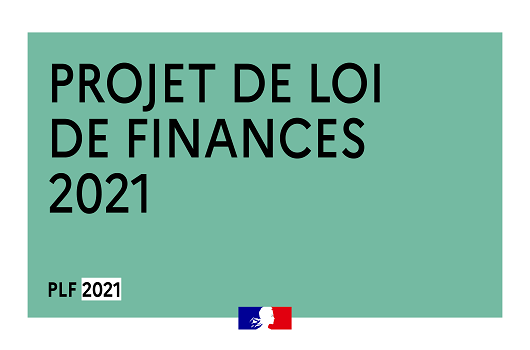2021 French Finance Law and Measures affecting Investment Real Estate Sector

The draft French Finance bill for 2021 (projet de loi de finances PLF), presented on September 27, 2020 to the Council of Ministers and before discussion at its first reading in the National Assembly will begin on October 12, 2020, includes some measures taken in a difficult post-COVID economic context that will concern the real estate sector and that should be examined carefully.
Article 5 : The return to grace of free revaluation?
The mechanism for the free revaluation of fixed and financial assets provided for in Article L 123-18 of the French Commercial Code makes it possible, by updating the value of a company’s assets, to improve the presentation of shareholders’ equity by adding unrealized capital gains, which are recorded in a “revaluation surplus” reserve account.
This revaluation difference is not distributable (except in the event of the realization of the assets concerned and/or for the portion of additional depreciation) but may be incorporated into the capital to be used for a loss write-off operation by means of an “coup d’accordéon coup” (capital increase followed by a reduction).
From a tax point of view, this revaluation difference (the unrealized capital gain resulting from the difference between the present value and the net book value) constitutes a taxable income subject to tax at the standard rate (article 38-2 of the French General Tax Code). This profit may be offset against any losses carried forward in accordance with the rules currently in force: allocation limited to 1 million euros per year plus 50% of the fraction of profit above this threshold. In the experience of Primexis’ Real Estate department, several free revaluation operations have been abandoned due to the tax impact resulting from the limitation of the use of prior year carryforward losses.
Without going back to the legal revaluation regime of 1976 and looking closer to us, between 2004 and 2009, article 238 bis JA of the French General Tax Code already provided for corporate income tax at the reduced rate of 19% (16.5% before 2009), i.e. the exit tax rate from the SIIC regime, provided that the assets were kept for a minimum period of 5 years. Once again this measure was not met with much success at least in our clients perspective
In the finance bill for 2021, the legislator provides for the option of not taking into account the revaluation difference recognized in determining taxable income for the year provided that the following conditions are met:
- calculate the subsequent gain or loss on the disposal of non-depreciable fixed assets on the basis of their unrealized value, and
- to reintegrate the revaluation surplus relating to depreciable fixed assets into taxable income. The revaluation surplus is reintegrated in equal parts over a period of 15 years for buildings and over a period of 5 years for other fixed assets,
- immediately tax the portion of the revaluation surplus resulting from the disposal of a depreciable fixed asset that has not yet been reintegrated at the date of disposal,
- calculate depreciation, provisions and subsequent gains on disposals relating to depreciable fixed assets on the basis of the value assigned at the time of the revaluation
- to attach to the income statement for the revaluation year and subsequent years a statement in accordance with the model provided by the administration showing the information necessary to calculate the depreciation, provisions or capital gains or losses relating to the fixed assets that have been revalued.
These provisions will come into force after discussions and amendments at the latest by the end of December 2020, for fiscal years ending on or after December 31, 2020 and until December 31, 2022.
It appears that the legislator wishes, through this text and through a virtually tax-free operation for depreciable assets, to allow companies to strengthen their shareholders’ equity through a simple operation of free revaluation of fixed and financial assets.
However, it will be up to each company to examine its situation with regard to article 5 of the draft French Finance bill for 2021. Primexis’ Real Estate department is at your disposal to assess the attractiveness of this measure for your real estate structures.
Article 6 : Sale and leaseback transactions
In order to facilitate the refinancing of companies affected by the consequences of the health crisis and enable them to rebuild their cash position, the purpose of this article is to restore the mechanism for spreading the capital gain on the sale of a building under a sale-leaseback transaction provided for in Article 39 novodecies of the French General Tax Code (CGI), initially implemented following the financial crisis of 2008.
Sale-leaseback is the operation by which a company that owns a professional real estate property sells it to a real estate leasing company (lessor) and simultaneously takes it under a real estate lease and becomes a tenant (lessee). The leasing contract is accompanied by a purchase option allowing the selling company to buy back its building, either during or at the end of the contract. The advantage of this financing technique is that it allows the seller who has become a lessee to retain the use of the building it previously owned while restoring its cash flow. The operation thus enables him to quickly obtain cash, which, in the current context, can be particularly useful to businesses.
In the absence of an overriding provision, the capital gain realized by a company on the sale of a building to a leasing company is taxed in full for the fiscal year in which the asset is sold, including in the event that the company regains immediate use of the asset in the context of a sale-leaseback transaction.
The purpose of the proposed measure, which consists of spreading, as an option, the taxation of capital gains on disposals over the term of the leasing contract, is to enable companies to improve their cash flow by resorting to sale and leaseback transactions.
Spreading the capital gain over the term of the leasing contract, without being able to exceed fifteen years, ensures the tax neutrality of the operation for the company, which reintegrates the capital gain as and when the leasing rents are deducted. The budget balance for the State is neutral over the entire duration of the operation. This capital gains tax smoothing measure therefore allows companies to quickly obtain cash by realizing the unrealized capital gains that exist on their buildings, without immediately paying the full tax on these capital gains.
Article 3 : Reduction of the contribution on the added value of companies up to the share allocated to the regions and adjustment of the ceiling rate of the territorial economic contribution according to the value added
The contribution on the added value of companies (CVAE) represents a preponderant share of production taxes, with, in 2019, an income of approximately €19 billion, distributed among the three levels of local authorities. Around 21% of the CVAE paid by companies is paid by the manufacturing sector. It particularly penalizes companies that need to regularly renew their production tools and the most capital-intensive sectors.
This article proposes to lower as of 2021 the CVAE rate to the extent of the share allocated to the regional level, i.e. 50%, from 1.5% to 0.75% and, correlatively, to review the financing scheme of the regions by replacing the CVAE with a dynamic resource: a fraction of the value added tax (VAT).
To avoid any crowding out effect, particularly to the disadvantage of industrial sectors, the cap on the territorial economic contribution (CET) based on value added will be lowered from 3% to 2%.
Partner
Real Estate Department
 Alexis Gasto
Alexis Gasto Partner
International Business Services
 Daniel Wickers
Daniel Wickers

